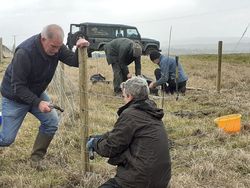The Worcester and Malvern RSPB Group
The Worcester and Malvern local RSPB group has had a busy summer installing swift and owl boxes, and taking part in several projects to improve habitats across Worcestershire. Simon Evans from the local group tells us more.
To say we have had a busy summer at the RSPB Local group would be an understatement. We have a project providing nestboxes for Barn Owls and will soon have forty around the county to monitor. Our annual Swift project has seen 30 swift boxes put up on Malvern houses this year. We have continued to feed a thriving population of Corn Buntings near Evesham and are monitoring the few remaining Curlews that breed in our area as part of a national initiative.
We work with the excellent Wildgoose Care Farm on their reserve, help the University of Worcester grow and study a winter birdseed crop, and are helping Malvern Hills District Council restore flood meadows on the River Severn near Hallow. We are also involved with wellbeing walks in Worcester, the Heart of England Forest near Pershore, the National Trust at Croome, and we are setting up links with local schools to spread the conservation message to the next generation. To help us do these things, in the Spring we raised over £20,000 by crowdfunding linked to the Wild Isles BBC series.
On Diglis Island, viewed from the East Bank of the River Severn in Worcester, you can see a large wooden box raised above the ground on posts. This was a joint effort by the Worcester and Malvern local RSPB group, the Canal and Rivers Trust, and the Worcester Environmental Group. It is an artificial Sand Martin colony containing 30 nestboxes and was installed in March 2022.
Like Swallows and Swifts, Sand Martins depend on a good supply of flying insects both here, in sub-Saharan Africa where they spend the Winter, and along their migration route. Agricultural practices and climate change are threats that they face, and floods can destroy their usual nest sites in riverbanks. So we are delighted that they have taken to using the box we have provided.
From late May to August we carefully open the box at regular intervals so our team of expert ringers can weigh, measure, and ring the chicks, providing useful data to help conservation efforts. In its first year 43 chicks were ringed prior to fledging. This year that number has risen to 71.
As you can see, we are an active group with many enthusiastic members who, as well as volunteering for these projects, enjoy the walks, talks, and trips that we organise. New members can be sure of a warm welcome, whether they are experienced birders, people who wish to do voluntary conservation work, or people who just enjoy the birds in their local area.
If you would like to join us please get in touch with me, Simon Evans, group Secretary, at sjandjw@gmail.com. Any leads to possible future projects are also very welcome.


